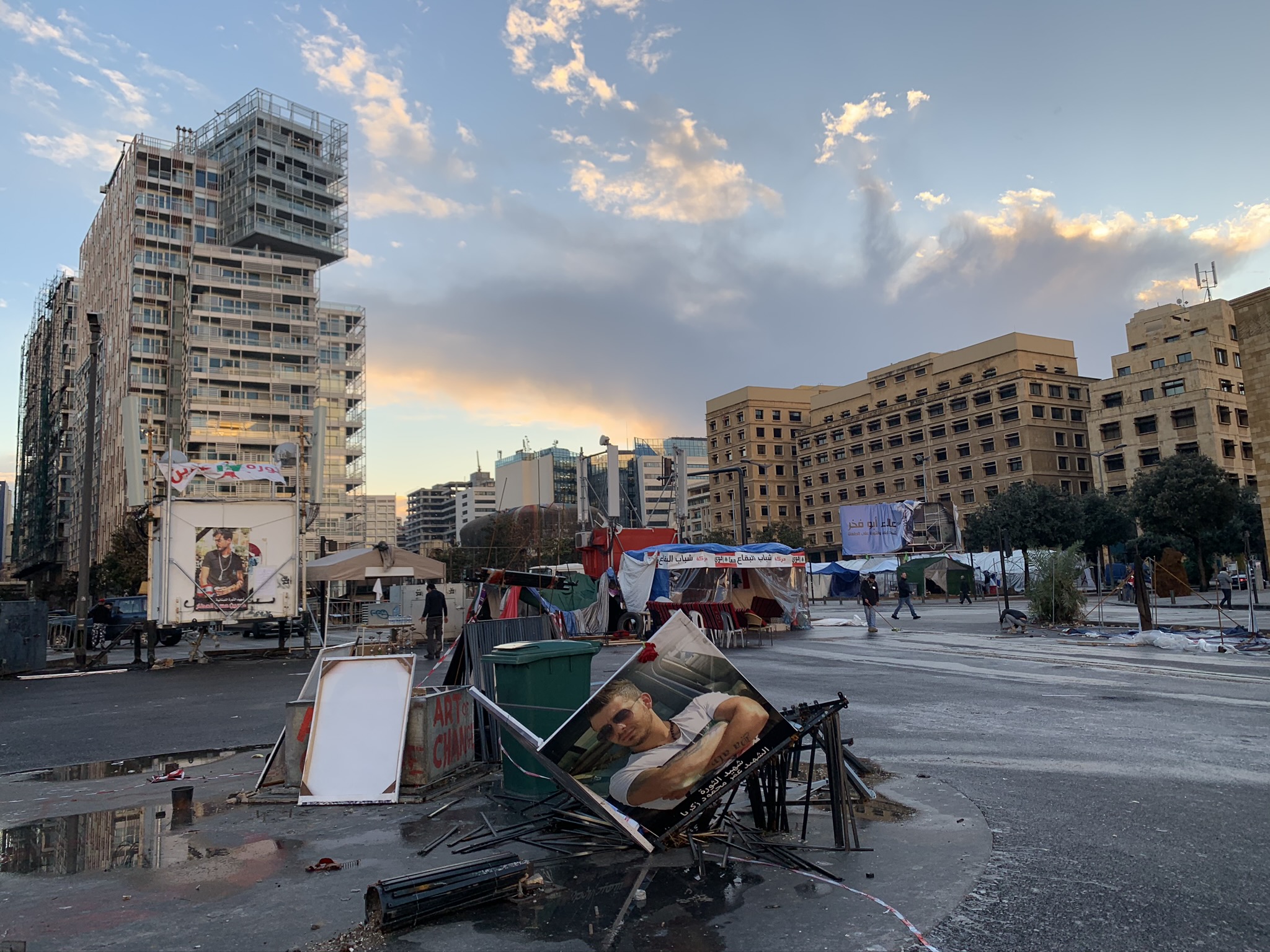When we visited my in-laws in Lebanon last Christmas, the country was emerging from nearly three months of fierce protests, sustained shutdowns and road closures that had both galvanized and paralyzed society, while effecting little real change. In October, Lebanon’s cash-strapped government had threatened to tax VOIP services like WhatsApp, igniting a wave of popular anger not seen since 2005, when mass protests forced the withdrawal of Syrian forces after more than two decades of occupation.
Riding this wave of fury, hundreds of thousands of Lebanese gathered in Martyr’s Square to demand the ouster of the warlords-cum-politicians who have nominally governed the country since the civil war ended in 1990. The unique power-sharing agreement under which they have ruled was meant to promote peaceful co-existence between the country’s 18 religious sects by redistributing power among them based on each group’s perceived demographic weight (keep in mind that Lebanon has not conducted a census since 1932). In reality, the deal gave each of Lebanon’s entrenched political leaders a personal fiefdom within the state to skim and dispense patronage from at will, as infrastructure, running water, electricity, trash collection and other basic services deteriorated and the cost of living skyrocketed.
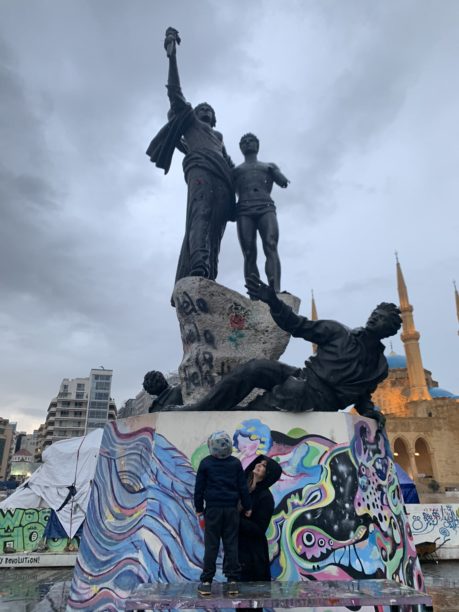
In the beginning, the mood of the October uprising was jubilant and evoked the same sense of hope that emerged in the wake of the 2005 demonstrations that had drawn me to move to Beirut for my first journalism job at the English-language paper, The Daily Star. Even more promisingly than in 2005, the October demonstrations temporarily obscured traditional economic and sectarian splits: in downtown Beirut, Maronite Christian aristocrats from the posh French-speaking quarters of Tabaris joined Shiite residents of the southern suburbs all chanting, “Killoun, yanni, Killoun,” (“All of them means all of them”), and “Thawra” (“Revolution”).
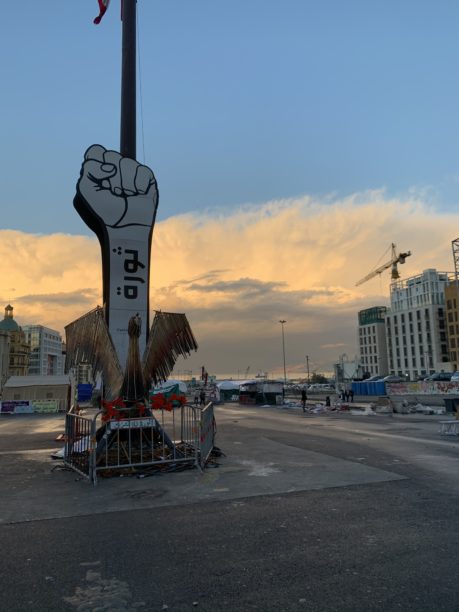
As my husband Charbel and I watched the protests unfold from our home in Brooklyn, I wondered if this would be the final straw to break the back of the anemic Lebanese state. Charbel, whose family stayed in Lebanon throughout the entire 1975-1990 Civil War, was proud of what he was seeing, but insisted that only armed struggle would unseat the political class.
When we got to Beirut for our annual Christmas trip, he appeared to be correct. We arrived as two weeks of showers helped pause the revolution for the holidays. A new prime minister was about to take office, and the demonstrations were dwindling. When I asked Beirutis about the revolution, everyone agreed that it had been a euphoric moment for the country, but most were doubtful that things would change and were worried about more pressing economic problems.
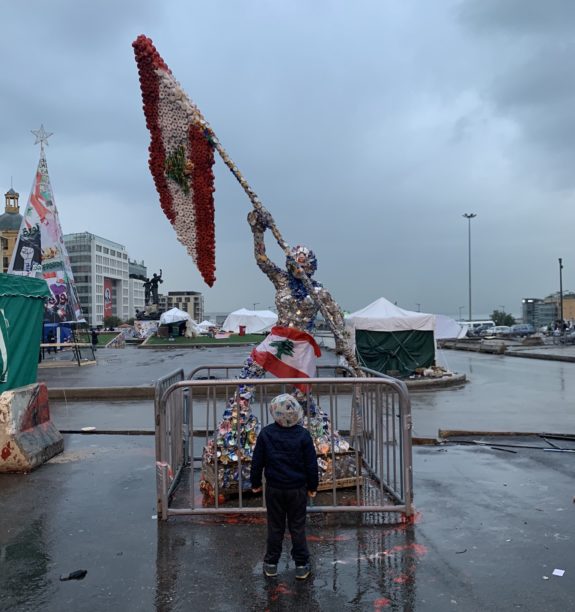
While Charbel took our two kids to visit his family in Jounieh, a Christian suburb just outside the city, I treated myself to a day of walking around Beirut.
Beirut is not an easy city to traverse on foot for a number of reasons, most of which boil down to the same problem that pushed the Lebanese into the streets in October: a weak, negligent and broken state. It’s the same reason nearly all Beirutis have generators to provide electricity when the state-owned power grid goes dark; it’s why most of them pay private trucks to fill the water cisterns on their roofs, in case the state supply stops flowing from their faucets.
This festering neglect turned deadly on August 4th, when a fire started at a warehouse at the Beirut port and ignited nearly 3,000 tons of explosive ammonium nitrate that had languished there for six years with the Lebanese authorities’ full knowledge. The explosion killed at least 220 people, according to the Beirut City Governor, left 300,000 homeless, and caused an estimated $3 billion in damage.
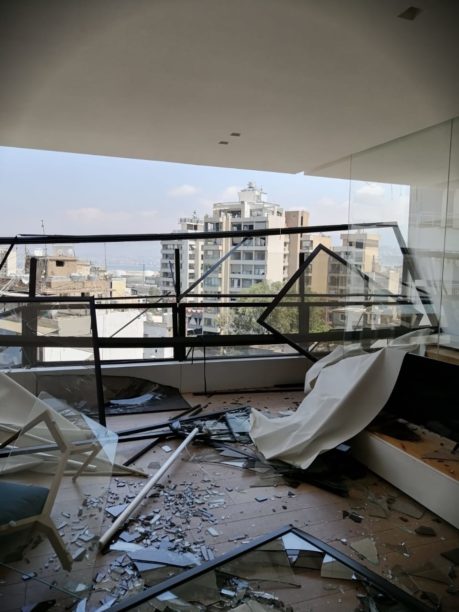
The blast has taken a profound psychological toll on the Lebanese people because it battered the most architecturally significant neighborhoods in Ashrafieh, the eastern portion of the city that is home to a mishmash of bars, crumbling Ottoman-style homes, gleaming skyscrapers, art galleries, car mechanics, bodegas, stray cats, valet parking attendants, and triple-parked cars.
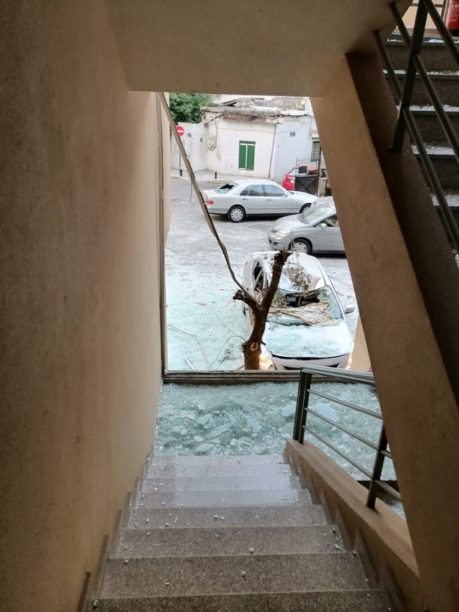
In the wake of the disaster, citizens gathered to clean up debris on the glass-strewn streets of Gemmayze and Mar Mikhael—the two neighborhoods I’ve lived in for most of my time in Beirut—as the army and security forces merely looked on, showing that once again, the government is not going to help clean up or take responsibility for what it claims was an accident.

This will not be the first time the state has abdicated its responsibility for rebuilding Beirut. During the civil war decades ago, the center of downtown—traditionally a bridge between the majority-Christian eastern half of the city and the mainly Muslim western half—was destroyed. Then-premier Rafic Hariri founded Solidere, a private company to spearhead the reconstruction of central Beirut, in the 1990s, and the company has been mired in controversy, criticism, and corruption charges ever since.
Though it is one of the few pedestrian-friendly parts of the city, Solidere has been accused of remaking downtown Beirut into a playground for wealthy Gulf tourists and the well-heeled Lebanese diaspora, instead of creating a commercial district that brings different classes together in an integrated community.
Even after reconstruction, it is still difficult to get from one side of Beirut to the other on foot. Whatever route you take, to get from Ashrafieh to the western side, at some point you’ll be forced to run across a lawless stretch of highway. This never gets easier. I used to cross the four-lane intersection dividing Gemmayze and Saifi Village at least four times a day on my walks to and from work, as a hapless crossing guard looked on, and felt like I was taking my life into my hands every single time.
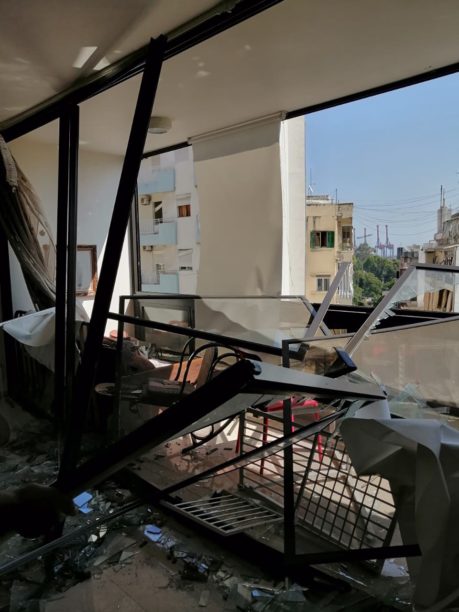
The failure of the state makes Beirut unfriendly to pedestrians in many other ways too—there are not many sidewalks, for example, and the few that exist are usually blocked, either with cars or construction vehicles and equipment. There is no zoning, and even before the explosion wiped out so much of the historic quarter, many of the country’s crumbling French-mandate era buildings had already been destroyed by developers hungry for petrodollars. So those with means drive their own cars, and the poor wait on Beirut’s busier streets for unmarked minibuses or the shared taxis known as services, whose drivers honk to ask pedestrians if they’d like a ride.
I like to walk whenever possible, and my favorite route is the two-mile stretch from downtown, through Saifi Village and Gemmayze to our apartment at the end of Mar Mikhael on the outskirts of the Armenian quarter of Bourj Hammoud. Those neighborhoods were among the worst-hit areas in the explosion. I didn’t know, back in December, that it was the last time I’d get to walk through the parts of the city that felt most like home to me.
I saw evidence of the intractable standoff between the government and its people everywhere in the reconstructed center of downtown. Cement barricades blocked the entrance to Nejmeh Square, which houses the parliament, as well as the husks of hundreds of restaurants and shops, emptied when the 2006 war triggered a retail exodus from Solidere.
Nejmeh Square had been reclaimed for a time as public space where kids scootered and biked and fed pigeons. On our last trip, even the Starbucks that had stuck it out to cater to their parents had finally shuttered. Banks and shops in Saifi Village, the astronomically expensive so-called artists’ quarter dividing downtown Beirut from Ashrafieh, were mostly closed as well, with windows smashed and anti-government graffiti scrawled on their facades.
But in December, Gemmayze, Mar Mikhael, and much of the area at the epicenter of the August 4th blast, felt relatively untouched by the wave of protests that had paralyzed the rest of the country. People smoked and drank coffee outside the manicured hedges of the French cafe Paul, and ate quinoa salads and drank wine at concept stores like Urbanista. They spilled out of bars that have weathered wars and recessions, like Dragonfly and Torino.
I stopped to say hello to Ali, a soft-spoken parking valet on Gouraud Street, whom I first met when he worked as a security guard at The Daily Star‘s offices. Ali lived in Dahiyeh, the southern suburbs of Beirut often referred to as a “Hizbollah stronghold” in the western press. Back in 2006, when I was new to the country, Ali took me and my colleague on a tour of Dahiyeh the day after the ceasefire that had ended Israel’s latest war in Lebanon.
After 34 days of Israeli bombing, Dahiyeh in 2006 looked much like Ashrafieh does now, after the explosion. The dense neighborhood, home to Shiites across the socio-economic spectrum, was covered in heaps of rubble and glass. Some of these bore flags that read “Made in America” in both English and Arabic, courtesy of Hizbollah. Residential buildings were ripped in half, peoples’ bedrooms and belongings exposed like life-sized dollhouses.
Much like the residents of Ashrafieh today, the people in Dahiyeh wept as they swept the remnants of their homes into piles, with tragically mundane objects like a toddler’s shoe or a Sesame Street book poking through. But in the wake of the 2006 war with Israel, Hizbollah had taken care of the heavy cleanup in place of the listless government, using its quick rebuilding to brand itself as the resistance party and the savior of Lebanon.
The rifle-emblazoned green and yellow flag of Hizbollah is ubiquitous in Dahiyeh, while our neighborhood on the edge of Mar Mikhael abounds with religious shrines and monuments to the various assassinated members of the Gemayel clan, the Maronite Christian family who founded the Kataeb, a major political party, in the 1930s. Near our apartment there’s a mosaic billboard of a Kataeb official kneeling in front of a cedar tree, giving a Nazi salute; the party was originally modeled on European fascist governments in Spain and Italy. It was still there in December, though a huge poster of the assassinated civil war hero Bachir Gemayel had been removed by anti-government protestors. Sami Gemayel, his nephew, now heads the party.
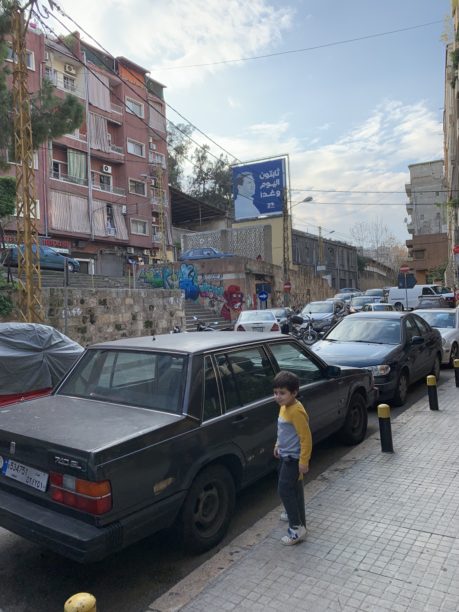
Our apartment is right near the blast site, so I imagine the billboard has probably fallen now too.
I walked toward the Armenian quarter of Bourj Hammoud, wove my way through the residential streets of Mar Mikhael, and took in the familiar rhythms of the neighborhood—the man selling Turkish coffee from a metal thermos strapped to his back; the booming voice of the vegetable seller from the Bekaa valley who drives his truck around everyday shouting what he has for sale through a megaphone; the geriatric residents on fourth-floor balconies easing baskets with money down on rope pulleys to buy their produce for the day; the uniformed Ethiopian domestic workers navigating yapping puppies along the tiny sidewalks that are inevitably blocked by cars and packs of friendly stray cats.
In Beiruti parlance, I live in Mar Mikhael, by the nightclub Mandaloun—turn at the Bible Book Shop by Jisr Hadeed (the old bridge). No one uses addresses in Beirut, so landmarks past and present guide people through city. Even if a landmark gets destroyed, people still call it by its old name sometimes, like “Cola,” a well-known neighborhood that used to be home to a cola factory.
That’s Beirut—a city navigated by the collective memory of its residents. It is this collective memory and spirit, rather than any state assistance, that will, in time, piece together the historic neighborhoods destroyed by the August 4th blast. Jisr Hadeed was gone last December. It either fell or was torn down. But I still told taxi drivers to drop me there.

